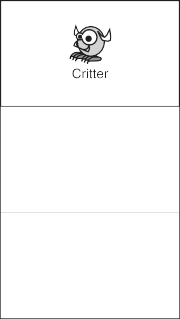
< Previous | Contents | Next >
The core of the game is the critter itself. Therefore, I first plan my Critter class. Because I want the critter to have independent hunger and boredom levels, I know that the class will have private data members for those.
n m_Hunger
n m_Boredom
The critter should also have a mood, directly based on its hunger and boredom levels. My first thought was to have a private data member, but a critter’s mood is really a calculated value based on its hunger and boredom. Instead, I decided to have a private member function that calculates a critter’s mood on the fly, based on its current hunger and boredom levels:
n GetMood()
Next, I think about public member functions. I want the critter to be able to tell the player how it’s feeling. I also want the player to be able to feed and play with the critter to reduce its hunger and boredom levels. I need three public member functions to accomplish each of these tasks.
n Talk() n Eat() n Play()
Finally, I want another member function that simulates the passage of time, to make the critter a little more hungry and bored:
n PassTime()
I see this member function as private because it will only be called by other member functions, such as Talk(), Eat(), or Play().
The class will also have a constructor to initialize data members. Take a look at Figure 8.6, which models the Critter class. I preface each data member and
276 Chapter 8 n Classes: Critter Caretaker
member function with a symbol to indicate its access level; I use + for public and
– for private.

Model for the Critter class.